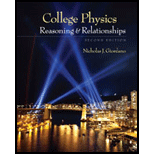
Concept explainers
The gravitational force of Jupiter on the earth, and compare the result with the magnitude of gravitational force on earth from the sun.
Answer to Problem 54P
The gravitational force of Jupiter on the earth when it is closest to earth is
Explanation of Solution
Write the expression for gravitational force of the sun on the earth.
Here,
Write the expression for gravitational force of Jupiter on the earth when it is closest to earth.
Here,
Write the expression for gravitational force of Jupiter on the earth when it is furthest to earth.
Here,
Conclusion:
Substitute
Substitute
Substitute
Therefore, the gravitational force of Jupiter on the earth when it is closest to earth is
Want to see more full solutions like this?
Chapter 5 Solutions
College Physics
- Because the Earth rotates about its axis, a point on the equator experiences a centripetal acceleration of 0.033 7 m/s2, whereas a point at the poles experiences no centripetal acceleration. If a person at the equator has a mass of 75.0 kg, calculate (a) the gravitational force (true weight) on the person and (b) the normal force (apparent weight) on the person. (c) Which force is greater? Assume the Earth is a uniform sphere and take g = 9.800 m/s2.arrow_forwardwhat is the direction of the net gravitational force on the mass at the origin due to the other two masses? a) +x direction b) -x directionarrow_forwardThe tallest spot on Earth is Mt. Everest, which is 8850 m above sea level. If the radius of Earth to sea level is 6359 km, how much does the gravitational field strength change between the sea level value at that location (9.826 N/kg) and the top of Mt. Everest?arrow_forward
- a)What is the acceleration due to gravity on the surface of the Moon? m/s2 (b)What is the acceleration due to gravity on the surface of Venus? The mass of Venus is 4.87 ✕ 1024 kg and its radius is 6.05 ✕ 106 m. m/s2arrow_forwardWhat is the approximate magnitude of the gravitational force exerted by the Sun on the Voyager 1 spacecraft when they are separated by 17.0 billion kilometers? The spacecraft has a mass of 731 kg.arrow_forwardAn object of mass 10 kg is released from rest above the surface of a planet such that the object’s speed as a function of time is shown by the graph below. The force due to gravity exerted on the object is most nearly a 35 N b 3.5 N c 7 N d 70 Narrow_forward
- Does an apple exert a gravitational force on the Earth? If so, how large a force? Consider an apple (a) attached to a tree and (b) falling.arrow_forwardThe weight of bodies may change somewhat from one location to another as a result of the variation of the gravitational acceleration g with elevation. Accounting for this variation using the relation g = a − bz where a = 9.807 m/s2 and b = 3.32 × 10−6 s−2, determine the weight of an 80-kg person at sea level (z = 0), in Denver (z = 1610 m), and on the top of Mount Everest (z = 8848 m).arrow_forwardAn 76 kg satellite orbits a distant planet with a radius of 4500 km and a period of 280 min. From the radius and period, you calculate the satellite's acceleration to be 0.63 m/s2. What is the gravitational force on the satellite? ______ Narrow_forward
- What is the value of the acceleration on the surface of a planet that has twice the mass of Earth and twice its radius?arrow_forward(a) What is the acceleration due to gravity on the surface of the Moon? (b) What is the acceleration due to gravity on the surface of Venus? The mass of Venus is 4.87 ✕ 1024 kg and its radius is 6.05 ✕ 106 m.arrow_forwardTwo spherical objects having weights W1 = 2200N and W2 = 3600N are separated by a distance of 22.4m between their centers of mass. The force of gravitational attraction between these two objects is________Narrow_forward
 College PhysicsPhysicsISBN:9781305952300Author:Raymond A. Serway, Chris VuillePublisher:Cengage Learning
College PhysicsPhysicsISBN:9781305952300Author:Raymond A. Serway, Chris VuillePublisher:Cengage Learning College PhysicsPhysicsISBN:9781285737027Author:Raymond A. Serway, Chris VuillePublisher:Cengage Learning
College PhysicsPhysicsISBN:9781285737027Author:Raymond A. Serway, Chris VuillePublisher:Cengage Learning Principles of Physics: A Calculus-Based TextPhysicsISBN:9781133104261Author:Raymond A. Serway, John W. JewettPublisher:Cengage Learning
Principles of Physics: A Calculus-Based TextPhysicsISBN:9781133104261Author:Raymond A. Serway, John W. JewettPublisher:Cengage Learning Physics for Scientists and Engineers, Technology ...PhysicsISBN:9781305116399Author:Raymond A. Serway, John W. JewettPublisher:Cengage Learning
Physics for Scientists and Engineers, Technology ...PhysicsISBN:9781305116399Author:Raymond A. Serway, John W. JewettPublisher:Cengage Learning



